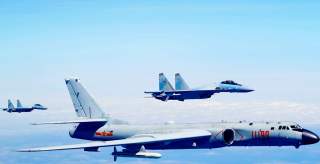This Picture Is the Air Force's Nightmare: China's Air Force Has the Su-35
What happens now?
With the jets now in service, the Su-35 would significantly bolster Chinese forces operating over the South China Sea or the Taiwan Straits. I
The Sukhoi Su-35 Flanker-E has entered service with the People’s Liberation Army Air Force (PLAAF) according to the Chinese Ministry of Defense. The advanced Russian-built fourth generation fighter is a significant boost to the PLAAF and could be used to good effect by Beijing in over the South China Sea.
(This first appeared earlier in 2018.)
“The Su-35 is a multi-purpose fighter jet capable of air combat and precision strike against land and surface targets,” Senior Colonel Wu Qian, Director General of the Information Office of China's Ministry of National Defense, said during a April 26 press conference. “Currently, the aviation troop units of the PLA Air Force have been armed with the Su-35 fighters.”
With the jets now in service, the Su-35 would significantly bolster Chinese forces operating over the South China Sea or the Taiwan Straits. Indeed, Beijing has in recent days been conducting exercises in the region near Taiwan, which it considers to be a breakaway province. “Recently, the PLA Air Force dispatched multiple types of warplanes to carry out real combat training exercises in the airspace over the sea to further enhance the capability of safeguarding China’s national sovereignty and territorial integrity,” Wu said. “The island the PLA warplanes patrolled around is, of course, China’s Taiwan Island.”.
Wu promised that China would take action if Taiwan were to attempt to formally declare independence. “The series of actions we have taken are targeting the ‘Taiwan independence’ forces and their activities, and are to protect the well-being of the people in Taiwan from being undermined by the ‘Taiwan independence’ conspiracy,” Wu said. “If the ‘Taiwan independence’ forces continue to act recklessly, we will take further actions.”
If push comes to shove, the Su-35 could feature prominently in any Chinese attempt to subdue Taiwan. The Flanker-E is arguably the PLAAF’s most capable fighter apart from the Chengdu J-20 stealth fighter, which is not likely to fully operational yet even if it has achieved some level of operational capability. Particularly, if the Su-35 is armed with long-range air-to-air missiles such as the very long range PL-15, it could be used to attack American aerial refueling tankers and other support aircraft such the E-3 AWACS that are crucial for conducting air operations over the vastness of the Pacific.
“The PL-15, could enter service during the course of 2018, and has already been cited by senior U.S. Air Force personnel as a significant concern, including remarks by Gen. Hawk Carlisle, then head of U.S. Air Combat Command, in 2015,” IISS military analyst Doug Barrie wrote for War on the Rocks. “The PL-15 may have a maximum range in the order of 200 kilometers and is thought to be fitted with an advanced seeker using an active electronically scanned radar. The maximum range describes how far the missile could reach with an optimized trajectory requiring no maneuvering and with little energy left at the end of the flight. But given that a missile in the class of the PL-15 would often be used to engage a combat aircraft of a similar class, its actual maximum engagement range against a maneuvering target would be considerably less, though likely still in excess of the present Western generation of solid-rocket medium-range missiles. One of the limitations of several of the current generation of beyond-visual- range AAMs is that the probability of a successful engagement is reduced significantly against a maneuvering target. This is because the missile rapidly bleeds off energy as it turns to try to close with the threat aircraft.”
Recommended: The World’s Most Secretive Nuclear Weapons Program.
Recommended: The Fatal Flaw That Could Take Down an F-22 or F-35.
Recommended: Smith & Wesson's .44 Magnum Revolver: Why You Should Fear the 'Dirty
An even more dangerous missile has already been spotted being carried onboard China’s own domestically developed J-16 advanced Flanker derivative, which is in some ways comparable to the Su-35 in capability. However, the Su-35 probably still has an overall edge over the Chinese Flanker knockoff. “An even longer-range AAM is also in the later stages of development,” Barrie wrote. “In late 2016, images appeared on the Internet of a Shenyang J-16 Flanker carrying two large missiles. The missile configuration suggested the design was intended to provide a very-long-range air-to-air capability, at up to around 400 kilometers, and intended to be used against tankers, airborne early warning and control aircraft, and intelligence surveillance and reconnaissance aircraft, at extended engagement ranges.”
Thus, the introduction of the Su-35 significantly boosts Chinese capability and increases the headaches for U.S. forces in the event of a war.
Image: Chinese Military.

